April 2018. “Why, here is Walden, the same woodland lake that I discovered so many years ago; … and I can almost say, Walden, is it you?” With those lines Henry David Thoreau conveys his personal relationship with Walden Pond, where he made a formative experiment in observing life that became the basis for Walden, his most famous book.
I had never before dipped my toes into Walden Pond, but I felt drawn to make a trip – a pilgrimage I should call it – to that same woodland lake that I had discovered so many years ago, when reading Walden as a college undergraduate. The pages of my cheap old paperback copy are now faded to yellow and getting a little crisp. Inside the cover page I wrote my name and room number of my freshman dorm – 41 Donner – I guess so someone could return it to me if I lost it. I didn’t, and now I treasure it as a source for understanding my debt to Thoreau. The marginal notes I made then are like blazes by the trails I walked with him in Walden woods. A tiny penciled check mark with an exclamation point stands in the margin next to, for example, “Not till we are lost, in other words not till we have lost the world, do we begin to find ourselves, and realize where we are and the infinite extent of our relations.”
I spent the night in a Quality Inn in Lexington, just off of Interstate 95, where the room reeked of carpet cleaner, and headed for Concord on a clear, sunny morning. The confident voice of the Google Maps girl navigated me westward, against the flow of morning rush hour traffic heading into Boston. Closer to Concord the route passed through genteel rural suburbs, with big old trees, big yards, and big colonial-style houses. I was on more or less the same route as the British marched on that famous 19th of April in 1775, when the Concord Minutemen met them at the “rude bridge that arched the flood,” and “fired the shot heard round the world” to begin the American Revolution. I stopped for breakfast in Concord, and then drove to Walden Pond State Reservation, parked in the large parking lot in front of the visitor center, and payed the daily non-resident parking fee of $15 by credit card.
Walden Pond is what is called a kettle pond by geologists. It was created when a chunk of ice broke off from the continental ice sheet that covered what is now New England about 12,000 years ago. Blocked by a ridge of rock to the south and abandoned by the retreating ice sheet, it melted, and all of the rocks, gravel, and sand ground off the continent by the ice formed the shoreline of the new pond. Walden is fed by precipitation and groundwater. Its water is crystal-clear and sparkling, filtered and purified by glacial sand.
I took the “Pond Path” from the eastern end of the pond around the north shore, the most direct route to the small cove above which Thoreau built his house in 1845. It was a glorious sunny spring morning, the temperature cool and perfect for walking, the pond sparkling with light ripples and reflecting the blue of a clear sky. There were a few scattered walkers and a few fishermen along the shore here and there, but relatively early on this weekday morning I had Walden mostly to myself.
I waded in. The water was cold but not unpleasant. So clear. The diversity of pebbles around my feet, glacier-ground pieces of rock from all over New England, was striking. On July 5th, 1845, one day after moving into his house on Walden’s shore, and speaking to the pond as if to a friend, Thoreau wrote in his journal: “Only the practiced ear can catch the surging words that break and die upon thy pebbled lips.” I resolved to listen as hard as I could to hear what Walden might have to say as gentle ripples splashed around my ankles on that bright April morning.
Thoreau was a complicated person and lived in a very complicated period of American history. I can’t pretend to do more than give a sketch of his life, and how he arrived at Walden Pond in the first place. For more details I highly recommend Laura Dassow Walls’s insightful and sympathetic biography, Henry David Thoreau: A Life (2017, University of Chicago Press), which piqued my curiosity to learn more about Thoreau and his life and times and motivated my pilgrimage to Walden.
A question from his Concord neighbor, friend and mentor, Ralph Waldo Emerson, was one important step leading Thoreau toward the pond and the book of the same name. “Do you keep a journal?” Emerson asked Thoreau in 1837, the year he graduated from Harvard. From his first journal entry on October 22, 1837, Henry began to record careful observations of his outer and inner life, observing as a scientist might, and amassing material that he could then revisit and communicate to others. Thoreau’s personality was deeply introspective, but he was also driven by a passion to communicate his explorations with family, friends, and the wider society around him through writing and lecturing.
Emerson was a model for Thoreau’s ambitions. He gave Henry an outlet for his writing in the Transcendentalist literary journal The Dial, where he published translations, poetry, and the first essay in his unique Thoreauvian style, “Natural History of Massachusetts,” in 1842. His “breakthrough” to a wider audience was an essay published in 1843 and titled “A Walk to Wachusett,” which I wrote about earlier. But Thoreau struggled to establish himself as a writer, self-funding his writing aspirations through work in his father’s pencil factory and as a teacher, handyman, and surveyor. In May 1843 he moved to Staten Island in hopes of advancing his writing career, living with Emerson’s brother William and tutoring his son, while also beating the streets of Manhattan to establish contacts in the publishing world and try to sell his writing. Thoreau was unhappy and unsuccessful in New York and moved back to Concord after seven months.
As early as 1841, Thoreau’s journal records his desire to live at Walden. “I want to go soon and live away by the pond, where I shall hear only the wind whispering among the reeds. It will be success if I shall have left myself behind. But my friends ask what I will do when I get there. Will it not be employment enough to watch the progress of the seasons?”
After returning from Staten Island, he finally got his chance. In 1842 Concord business promoters successfully lobbied for the new railroad from Boston to Fitchburg to pass through Concord. Less than two miles southeast of town, the railroad route cut close along the western shore of Walden Pond, spurring land speculation and development in the area. The woods around Walden soon filled with a shantytown of Irish railroad laborers. “Once passenger service opened in June 1844, running four trains daily from sunrise to dusk, Concord would forever be a Boston suburb,” writes Laura Walls.
Emerson, who had always loved Walden Pond and its woods, bought 14 acres on the north side of the pond in 1844 to protect it from development, and soon bought another 40 acres on the opposite side, including the high point that came to be called “Emerson’s Cliff,” where people speculated that he would build a “poet’s lodge.” Thoreau apparently saw his chance, and in early 1845 negotiated a deal with Emerson to build a cabin on his property on a cove on the north shore. He worked through the spring, and finally on the 4th of July, 1845, he spent his first night in his rustic house.
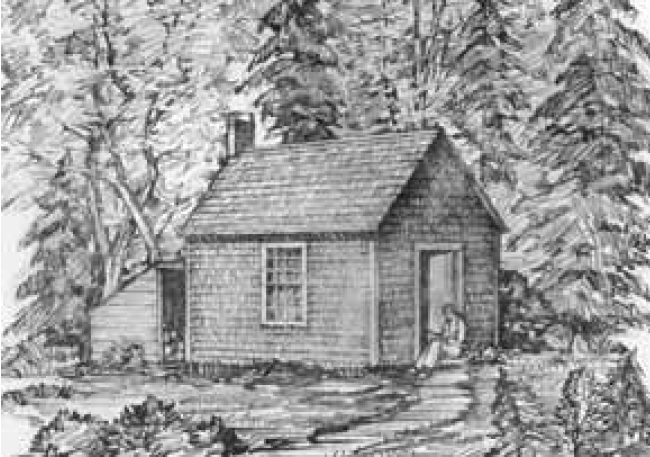
Sketch of Henry’s house at Walden by his sister Sophia, used as the basis of a lithograph on the title page of the 1854 edition of Walden, or Life in the Woods
Oh, here’s another one of those penciled blazes in the margin of my old copy of Walden now, as fresh and deep for this moment in time as it was then: “Every morning was a cheerful invitation to make my life of equal simplicity, and, I may say, innocence, with Nature herself. I have been as sincere a worshipper of Aurora as the Greeks. I got up early and bathed in the pond; that was a religious exercise, and one of the best things I did.”
Thoreau moved to the little house on Walden Pond with the intention of writing a book about a trip, in the summer of 1839 with his older brother John, to explore the Concord and Merrimac Rivers in the rowboat they had built together. Henry was very close to his brother, and John’s sudden death in January 1842 from tetanus was devastating. After a long recovery from grief he was determined to memorialize John through his writing. While living at Walden, Thoreau did write a book about that trip, A Week on the Concord and Merrimack Rivers, eventually published in 1849. It was a commercial failure. But he also kept up his journal, recording his experiences with the experiment in living at the pond. Those journal notes, reworked through seven revisions, were eventually published as Walden, or Life in the Woods in 1854 by Ticknor and Fields of Boston – eight years after Henry had moved back to town from his house by the pond. Walden soon established his reputation as writer and thinker, and he was a regular on the lecture circuit for the next eight years of his life, before it was cut short by tuberculosis.
Ah, here’s another blaze along the Walden trails in my old college copy: “At the same time that we are earnest to explore and learn all things, we require that all things be mysterious and unexplorable, that land and sea be infinitely wild, unsurveyed and unfathomed by us because unfathomable. We can never have enough of Nature. We must be refreshed by the sight of inexhaustible vigor, vast and Titanic features, the sea-coast with its wrecks, the wilderness with its living and its decaying trees, the thunder cloud, and the rain which lasts three weeks and produces freshets. We need to witness our own limits transgressed, and some life pasturing freely where we never wander.”
“Walden is based on Thoreau’s two-year experiment in living simply and thinking deeply…” says sign at the Concord Museum, where his writing desk, bed, and rocking chair are on display. I noticed the deliberate use of the word “experiment.” Thoreau was a scientist – a keen observer and recorder of both the outer and his inner worlds, and the relationship between them.
In the introduction to my old paperback copy of Walden, Walter Harding, a noted Thoreau scholar and biographer, wrote that “…Walden reaches its highest levels as a spiritual autobiography….to Thoreau and to the perceptive reader Walden is as much a religious document as any collection of sermons.” Harding describes the organization of chapters in Walden as “a careful alternation of the spiritual and the mundane… the practical and the philosophical.” When Thoreau went to Walden Pond, “His purpose was profoundly religious,” says his recent biographer Walls.
However, “Walden is a difficult book to read for three reasons,” according to Thoreau scholar and aficionado Ken Kifer. “First, it was written by a gifted writer who uses surgically precise language, extended, allegorical metaphors, long and complex paragraphs and sentences, and vivid, detailed, and insightful descriptions. Thoreau does not hesitate to use metaphors, allusions … personification, irony, satire … and he can shift from a scientific to a transcendental point of view in mid-sentence. Second, its logic is based on a different understanding of life, quite contrary to what most people would call common sense. … Thoreau … fills Walden with sarcasm, paradoxes, and double entendres. He likes to tease, challenge, and even fool his readers. And third, quite often any words would be inadequate at expressing many of Thoreau’s non-verbal insights into truth. Thoreau must use non-literal language to express these notions, and the reader must reach out to understand.”
Oh! There is so much to explore here! A walk around Walden demands some effort and imagination. Thoreau’s two years, two months and two days living at Walden Pond were life-changing and identity-forming for him. Walden is a place, both in the landscape of American ideas and the old glacier-scoured landscape of New England. The ideas and the land are linked, both have a history. For example, it was while living at Walden that Thoreau spent a night in the Concord jail for refusing to pay his poll tax because of his conscientious objection to slavery and the Mexican-American War, which was being fought largely to expand that institution to new territories of the United States. That experience led him to write his famous essay “On the Duty of Civil Disobedience,” which inspired both Gandhi and Martin Luther King. It was also during his stay at Walden Pond that, on a short trip to Maine to visit relatives, travel up the Penobscot River, and try unsuccessfully to climb Mt. Katahdin, he discovered the “sublime,” experiencing a personal feeling of “cosmos” – the great suprahuman universe that Alexander von Humboldt had been writing about. From his desk in his tiny house at Walden, with the frozen winter pond gleaming white out his south-facing window, he studied the Hindu Bhagavad Gita, the text of which had only just made its way to Concord, and found there an ancient cross-cultural link with his own transcendentalist, nature-based spirituality.
Here’s another blaze along the Walden trails: “Let us settle ourselves, and work and wedge our feet downward through the mud and slush of opinion, and prejudice, and tradition, and delusion, and appearance, that alluvion which covers the globe, through Paris and London, through New York and Boston and Concord, through Church and State, through poetry and philosophy and religion, till we come to a hard bottom and rocks in place, which we can call reality, and say, This is, and no mistake…”
Thoreau came to see and accept himself as a prophet and a contrarian, a teller of inconvenient truths about the human condition, about both its interior psychological landscape and the exterior ecological landscape our species was rapidly modifying. He is to me an ecophilosopher for the Anthropocene – more “modern” than our society has caught up with, mostly, either in its philosophical or political dimensions. Wandering the trails of Walden, I also came to see him as a man of marvelous innocence, integrity, and optimism. His curiosity and sense of wonder shine throughout Walden: “The universe is wider than our views of it,” he wrote.
But Thoreau’s deep radicalism triggered attacks from religious, political, and economic directions immediately, in his own day, in Concord and beyond. And – in an unexpected discovery from my pilgrimage to Walden – I have learned that those attacks are still continuing right up into our own day. I never would have guessed or known. Diving deeper into all that will have to wait for another essay.
For related stories see:
- A Walk on Wachusett. April 2018.
- Facing the Anthropocene in Florida: The Ecological Society of America’s 2016 Annual Meeting. August 2016.
- Time Travels in Alaska. September 2015.
Sources and related links:
- The Variorum Walden and The Variorum Civil Disobedience. 1967. Edited and with Introductions by Walter Harding. Washington Square Press.
- Walden Pond State Reservation, Massachusetts Department of Conservation and Recreation, informational brochure
- Walden Pond State Reservation Trail Map
- Henry David Thoreau: A Life. 2017. Laura Dassow Walls. U. of Chicago Press.
- A Week on the Concord and Merrimack Rivers PDF
- Walden and On the Duty of Civil Disobedience. Full searchable text PDF. WW Norton.
- Henry David Thoreau. The Journal 1837=1861. Damian Searls, Ed. 2009. New York Review Books.
- Walden Pond Wikipedia
- The Walden Woods Project
- Walden: Context from Sparknotes
- Analysis and Notes on Walden: Henry Thoreau’s Text with Adjacent Thoreauvian Commentary, by Ken Kifer.
- Mysteries of Thoreau, Unsolved. 2013. Rebecca Solnit. Orion.

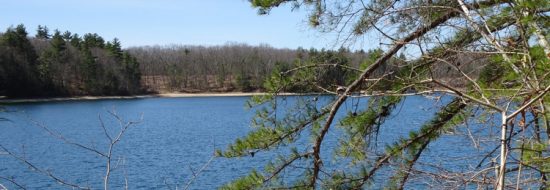
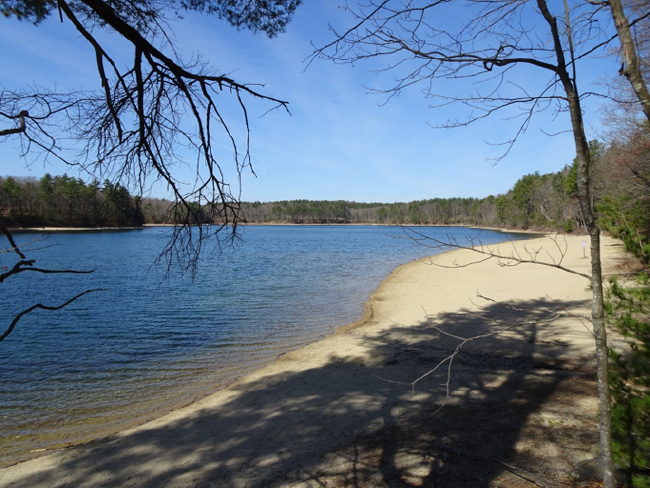
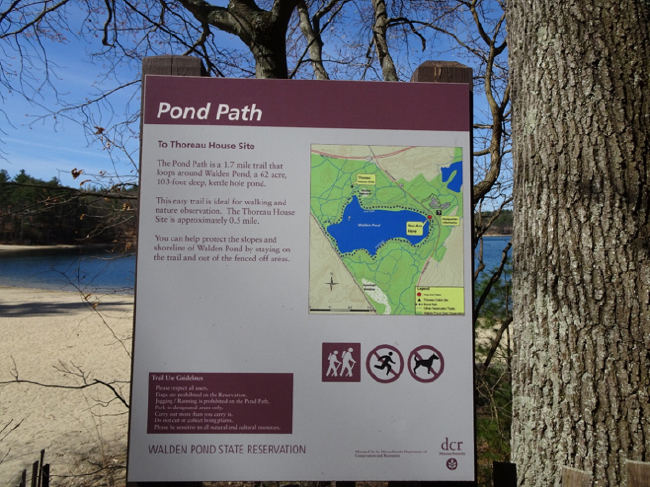
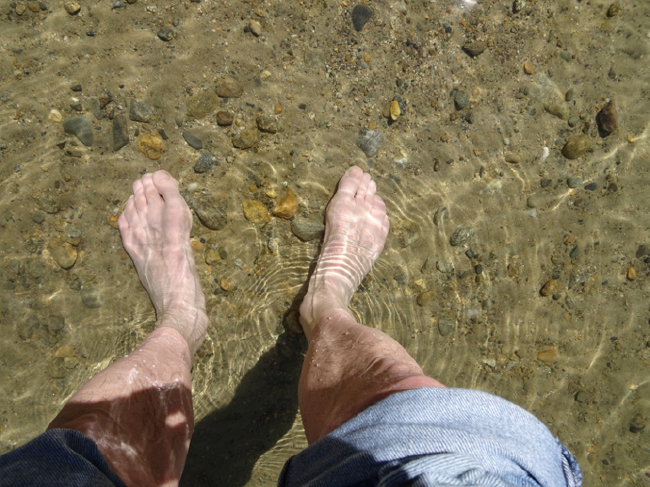

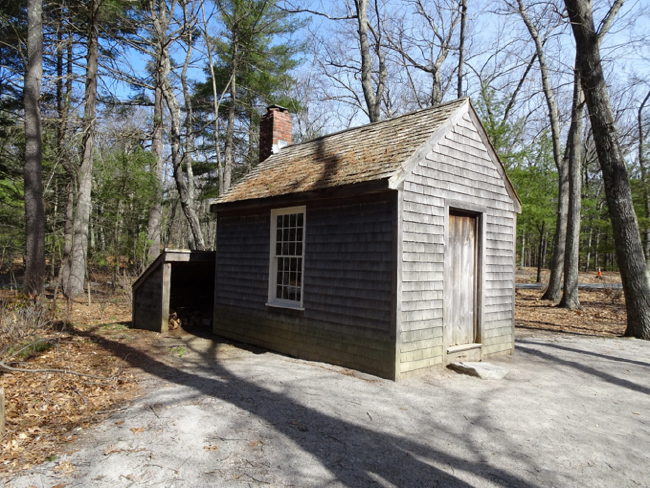
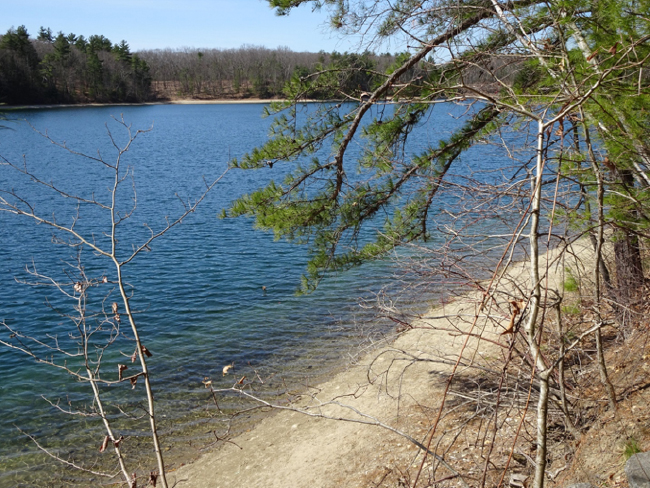
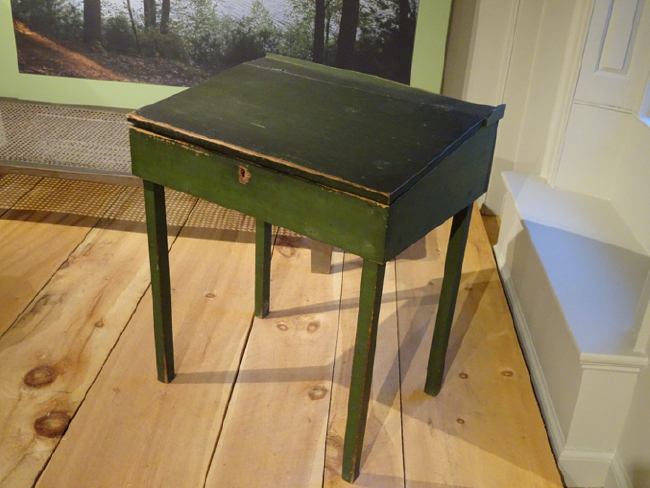
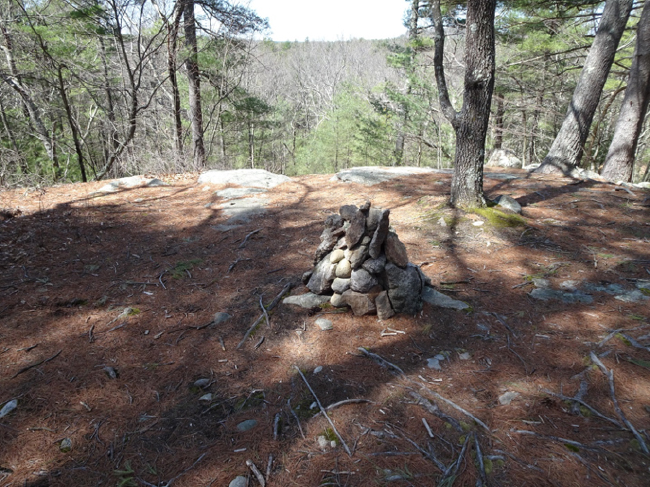
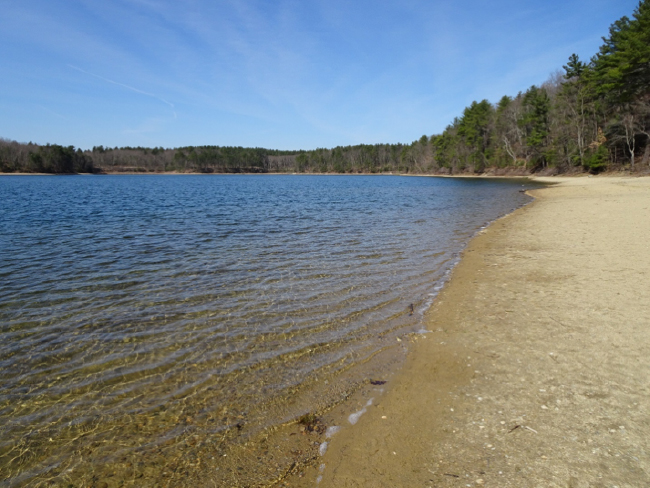



June 7, 2018 1:20 pm
Thanks for the research and insights. I’ve always been impressed by your perceptive and eloquent writing style.
I’m just back from a circumnavigation of Pennsylvania and depart tomorrow for week in Chicago staying with my sister. I’ll try to connect in July.
June 11, 2018 2:15 pm
Thanks for your kind comments Tim! Glad if you enjoyed wading in Walden with me.
June 7, 2018 5:12 pm
Bruce, as always, you wrote another inspirational essay about Thoreau and Walden. Your “blazes” in your copy of Walden is so similar to my own battered, treasured paperback copy from college days! I last visited Walden Pond in 1971, so I’m due another visit.
On a related note, are you a familiar with the book Thoreau as Spiritual Guide : A Companion to Walden for Personal Reflection and Discussion by Barry M. Andrews?
Best,
Harold
June 11, 2018 2:24 pm
Harold, good to hear from you and thank you for the supportive comments. It doesn’t surprise me that you also made blazes in the Walden woods, walking with Henry those many years ago. You are due for another walk around the pond; it may have changed a bit, but is still a place of inspiration.
I’m not familiar with that book, but from an online search it looks like it is still available; I’ll have a look. Thanks for the suggestion. In another essay from my recent trip to Walden — coming soon — I have tried to look at Thoreau’s spiritual side a bit more. And also talk about Muir’s “pilgrimage” to Concord in 1893, which I suspect you know all about.
Best wishes, Bruce